.gif)
Spotting (weight training)
Encyclopedia

Weight training
Weight training is a common type of strength training for developing the strength and size of skeletal muscles. It uses the weight force of gravity to oppose the force generated by muscle through concentric or eccentric contraction...
or resistance training
Resistance training
Resistance training has two different meanings. A broader meaning that refers to any training that uses a resistance to the force of muscular contraction , and elastic or hydraulic resistance, which refers to a specific type of strength training that uses elastic or hydraulic tension to provide...
, is the act of supporting another person during a particular exercise, with an emphasis on allowing the participant to lift or push more than he could normally do safely.
Correct spotting involves knowing when to intervene and assist with a lift, and encouraging a training partner to push beyond the point in which they would normally 'rack' the weight (return it to its stationary position).
Spotting relies partially on the placebo effect
Placebo effect
Placebo effect may refer to:* Placebo effect, the tendency of any medication or treatment, even an inert or ineffective one, to exhibit results simply because the recipient believes that it will work...
, whereby simply touching underneath a bar is enough to trick a person into believing that they are lifting a weight supported by their training partner which in turn may allow them to push one or two more repetitions beyond which they were normally capable and lower their hesitance to continue lifting, feeling safer with a spotter.
Spotting is particularly prevalent, and recommended when performing the bench press
Bench press
The bench press is an exercise of the upper body. For bodybuilding purposes, it is used to stimulate the pectorals, deltoids, and triceps. While on his or her back, the person performing the bench press lowers a weight to the level of the chest, then pushes it back up until the arm is straight...
. Because of the risks of lifting a heavy weight in the supine position, a lifter will often ask for a spot unless he or she is completely confident that the lift will not be failed. While a spotter may prevent injury, a lifter may become too dependent on the spotter, and not realize the degree that the spotter is assisting them. This is sometimes jocularly referred to as the "two man bench press".
Another exercise in which spotters are recommended is the barbell squat
Squat (exercise)
In strength training, the squat is a compound, full body exercise that trains primarily the muscles of the thighs, hips and buttocks, quads , hamstrings, as well as strengthening the bones, ligaments and insertion of the tendons throughout the lower body...
. Squats should be spotted by two spotters, one at each end of the bar. In the event of a missed lift, each spotter hooks an elbow under the end of the bar, and takes the plates in both hands. Care must be taken to keep the assistance balanced and coordinated to avoid uneven deloading of the weight and possible torsion injury. If two spotters are unavailable, a single spotter can assist by taking some of the weight of the bar allowing the lifter to return the weight to the rack. Unlike other exercises this exercise does not present much of a chance for the spotters to assist the lifter, as the spotters only intercede in the event of a missed lift.
Another exercise to utilize a spotter would be the triceps exercise Skull Crushers in which the lifter lowers an E-Z bar towards their head while laying flat on the bench. The spotter will be standing behind the individual and moving their hands approximately 6 inches below the bar so that they can catch it in the event of the lifter running out of energy.
Additionally, some people prefer to have a spotter present during the barbell military press
Military press
The military press is a variation of the overhead press weight training exercise using very strict form.The military press targets the deltoid muscles in the shoulders as well as the triceps...
or barbell push press (two very similar exercises). This exercise involves lifting a considerable amount of weight about the head. During this exercise the spotter will assist in “lifting off” the bar from the racked position. Then the spotter will keep his/her hands about 6 inches under the bar. This allows the spotter to assist when the lifter runs out of energy, but most importantly allows the spotter to catch the weight if the lifter cannot lift any more. A spotter may not be preferred, however, because the risk of injury is lower and it is easier to drop the weight on the ground if the lifter loses control of the barbell.

